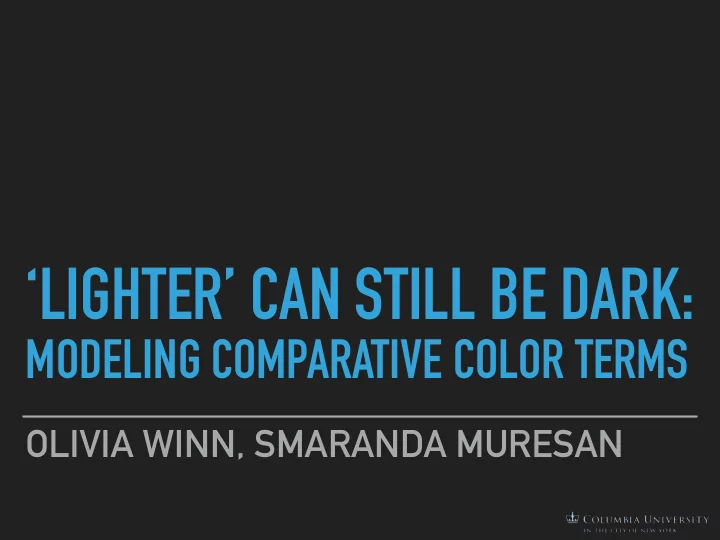

‘LIGHTER’ CAN STILL BE DARK: MODELING COMPARATIVE COLOR TERMS OLIVIA WINN, SMARANDA MURESAN
MULTIMODAL LEARNING � 2 ATTRIBUTE-BASED OBJECT RECOGNITION WHITE STRIPES ON WINGS WHITE STRIPES ON WINGS BLACK CROWN BROWN CROWN PALE TAN BELLY STRIPED BELLY Image Credit: allaboutbirds.org, txtbba.tamu.edu
MULTIMODAL LEARNING � 3 ATTRIBUTE-BASED OBJECT RECOGNITION Chickadee Sparrow = WHITE STRIPES ON WINGS WHITE STRIPES ON WINGS ≠ BLACK CROWN BROWN CROWN ≠ PALE TAN BELLY STRIPED BELLY Image Credit: allaboutbirds.org, txtbba.tamu.edu
MULTIMODAL LEARNING � 4 FINE-GRAINED OBJECT RECOGNITION Black-Capped Chickadee Carolina Chickadee = WHITE STRIPES ON WINGS WHITE STRIPES ON WINGS = BLACK CROWN BLACK CROWN = PALE TAN BELLY PALE TAN BELLY Image Credit: allaboutbirds.org, txtbba.tamu.edu
MULTIMODAL LEARNING � 5 FINE-GRAINED OBJECT RECOGNITION Black-Capped Chickadee Carolina Chickadee “MORE WHITE EDGING ON WINGS” Image Credit: allaboutbirds.org, txtbba.tamu.edu
MULTIMODAL LEARNING � 6 FINE-GRAINED OBJECT RECOGNITION Black-Capped Chickadee Carolina Chickadee “MORE WHITE EDGING ON WINGS” “LESS ORANGISH ON SIDES” Image Credit: allaboutbirds.org, txtbba.tamu.edu
MULTIMODAL LEARNING � 7 FINE-GRAINED OBJECT RECOGNITION Black-Capped Chickadee Carolina Chickadee “MORE WHITE EDGING ON WINGS” “LESS ORANGISH ON SIDES” WHITE STRIPES ON WINGS PALE TAN BELLY Image Credit: allaboutbirds.org, txtbba.tamu.edu
COMPARATIVE ADJECTIVES � 8 ATTRIBUTES VS. COMPARATIVES ▸ Attribute: set of feature values in isolation “ Dark teal ” ▸ Comparative: strength of feature with respect to a reference “ Darker teal ” ▸ Comparatives frequently used to distinguish similar colors [Monroe et al 2017]
COMPARATIVE ADJECTIVES � 9 ATTRIBUTES VS. COMPARATIVES ▸ Attribute: set of feature values in isolation “ Dark teal ” ▸ Comparative: strength of feature with respect to a reference “ Darker teal ” ▸ Comparatives frequently used to distinguish similar colors [Monroe et al 2017]
COMPARATIVE ADJECTIVES � 10 REFERENCE-BASED COMPARISONS DARKER [TEAL] DARKER [PINK]
COMPARATIVE ADJECTIVES � 11 REFERENCE-BASED COMPARISONS DARKER [TEAL] DARKER [PINK] DARKER [FOR PINK]
� 12 GOAL Ground comparative adjectives as directions in colorspace, dependent on the reference color , such that colors along the vector, when rooted at the reference color, satisfy the comparative
REFERENCES � 13 RELATED WORK ▸ Contextual color descriptions [McMahan and Stone 2015, Monroe et al 2017] ▸ Image ranking [Parikh and Grauman 2011, Yu and Grauman 2014] ‣ Comparisons of set sizes [Pezzelle et al 2018] ‣ Size ranking via knowledge graph [Bagherinezhad et al 2016]
METHOD � 14 DATA LIGHT BLUE LIGHTER BLUE 415 comparative tuples 79 unique reference labels 81 unique comparatives Source: McMahan and Stone, 2015
METHOD � 15 MODEL comparative adj: 300 dim. word2vec reference color: 3D RGB datapoint
METHOD � 16 MODEL GOLD OUTPUT Cosine Similarity Distance
ANALYSIS � 17 EVALUATION METRICS RGB Dist: 15 1. Cosine Similarity 2. Distance Delta-E: 6 Delta-E Perception ≤ 1.0 Imperceptible Requires close RGB Dist: 15 1 - 2 observation 2 - 10 Percievable More similar than 11 - 49 opposite Delta-E: 45 100 Exact opposites
ANALYSIS � 18 EXPERIMENTAL SETUP Data # Tuples # Dtpts Training 271 15.3M “Seen” Reference Test (Seen Pairings) 271 2.4M BLUE Test (Unseen Pairings) 29 0.29M Training Test (Unseen Ref.) 63 2.4M Testing Test (Unseen Comparative) 41 0.38M Test (Fully Unseen) 11 58k
ANALYSIS � 19 RESULTS Test Condition Avg Cos Avg Delta-E Test (Seen Pairings) 0.68 6.1 Test (Unseen Pairings) 0.68 7.9 Test (Unseen Ref.) 0.40 11.4 Test (Unseen Comparison) 0.41 10.5 Test (Fully Unseen) -0.21 15.9 Overall 0.65 6.8 Avg Cos: 50% above 0.80; 30% above 0.90
ANALYSIS � 20 RESULTS TEST TYPE REF COMPARATIVE GOLD COS SIM DELTA-E 0.97 0.9 Seen in training -0.76 20.0 0.94 4.2 Unseen pairing 0.77 12.3 0.93 2.7 Unseen reference -0.93 17.4 0.96 1.3 Unseen comparative -0.14 26.1 Unseen 0.99 3.5 reference & unseen -0.73 18 comparative
ANALYSIS � 21 REF COMPARATIVE GOLD greener —> yellower —> lighter —> darker —>
ANALYSIS � 22 COMPARING COLORS paler pastel REFERENCE TARGET powder tanner lighter
� 23 CONCLUSION ▸ New paradigm for grounding comparatives in colorspace ▸ New dataset of comparative colors ▸ Average cosine similarity: 0.65 , with 50% above 0.80 ▸ Model provides plausible comparative descriptions FUTURE WORK ▸ Apply to fine-grained object recognition ▸ Expand to other attribute domains
THANK YOU! QUESTIONS? Dataset available at: https://bitbucket.com/o_winn/comparative_colors
Recommend
More recommend